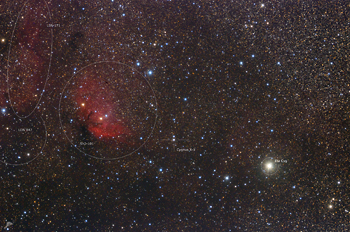 |
CHAMÄLEON + ONJALA OBSERVATORY DeepSky | SITEMAP HOME CHAMÄLEON |
|
 |
|||
| « back to overview Cluster | Load
higher resolution (1800 x 1200 Pixel 3500 x 2300
Pixel) |
Object description |

Cygnus X-1 (also known as the High-Mass X-ray Binary) is identical to the variable star V1357 Cygni, an extremely high-mass X-ray binary. The fact that the binary contains a black hole was discovered in 1972 by the Canadian astronomer Tom Bolton and it is the first actually existing black hole that could be detected by observations.
The mass of the black hole is estimated to be about 20 times the mass of the Sun, its age about 5 million years and its distance from the Solar System is 7,200 light years. Recent observations suggest that the black hole was not formed by a supernova, but that the precursor of the black hole in the Cygnus X-1 system may have been a Wolf Rayet star that collapsed.
The companion star is a blue-white supergiant of the spectral type O9.7 with the designation HD 226 868. Its surface temperature is about 30,000 degrees K and its mass is estimated at about 25 to 30 solar masses. The luminosity of the star is 200,000 times that of the Sun. The two components orbit each other with a period of 5.6 days at a distance of about 15 million kilometres. Visually, the Cygnus X-1 system has a brightness just under 9th magnitude.
The outer gas envelope of HD 226 868 is distorted in a teardrop shape by the black hole's gravity; the mass loss is estimated at 2.6 × 10 to the power of -6 solar masses per year.
Sh2-101 (LBN 168)
Furthermore, our image shows the emission nebula Sh2-101 (LBN 168), which is also called the Tulip Nebula. Sh2-101 is brighter and more filigree in the southern area, but mostly diffuse in the northern and western areas. The eastern area is dominated by branching dark clouds. The entire surrounding area of the nebula also glows faintly in the light of singly ionised hydrogen (LBN 171).
 |
In
the southwest, a dark cloud approaches the nebula - from the south - whose
foothills apparently imprint the dark structures on the nebula and which lies
between our solar system and Sh2-101. The two orange stars in the nebula are cooler stars. The star that excites the nebula northwest of the nebula's centre is HD 227 018 of spectral type O6.5. The brightest star in the field of view is Eta Cygni, showing a defect in the EDFS lens that unfortunately became much worse in 2021. In the meantime, the lens has been removed and is being repaired in Germany at Baader Planetarium in Mammendorf. « Click here and or on the thumbnail to load a large image with Annotations. |
 |
 |
 |
 |
 |
 |
 |
| Sun | Moon | Solar System | DeepSky | Widefield | Miscellaneous | Spec. Projects |